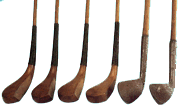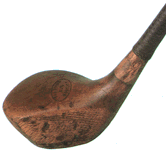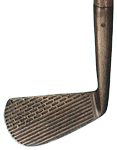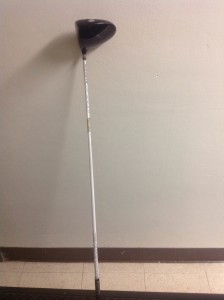Golf is probably one of the oldest sports in human history. To this day, the origin of golf still remains unclear, but the general belief is that modern golf gained popularity among aristocracy in Scotland during the Middle Ages (“History of Golf”). In the late 19th century, the game began to spread across the globe and eventually flourished in the United States. Over the course of years, technological advancement has changed golf equipment dramatically. In this post, I am going to examine the evolution of golf clubs throughout history.
First Generation Clubs:
In the earliest days of golf, players used primitive equipment and enjoyed the game in a casual manner. Initially, players would like to carve their own clubs from wood. However, they soon relied on experienced artisan to build their equipment. For example, in 1502, King James IV of Scotland commissioned a bow-maker to design his own set of clubs (“History of Golf Club”).

First-generation antique golf clubs
At that time, clubs heads were generally made from beech or holly trees; Shafts were made from ash or hazel, as shown the pictures below.

Beech club head and ash shaft
Due to the rudimentary techniques, at least one club was expected to break during each round. The cost, time and effort of manually producing a set of golf clubs were so great that golf was only limited to the upper echelons of society, until the advent of industrialization in 1760.
Second Generation Clubs:
In the 19th century, golf clubs underwent a series of evolutionary changes in material. First, in 1825, Robert Forgan, a club maker in Scotland, used hickory imported from America to manufacture shafts. Due to its relatively low cost, hickory quickly became the wood of choice for shafts.

Replica of hickory shafted clubs
Then, persimmon started to replace beech and other hard woods as the material of choice for club heads.

Persimmon club head
By 1900, many blacksmiths, such as Thomas Horsburgh, had been experimenting with metal-forged clubs, such as aluminum, to lower the cost and sharpen the performance.

Aluminum club
This gave birth to the modern golf clubs.
Third Generation Clubs:
Since the end of World War II in 1945, research in synthetic and composite materials has completely eliminated traditional material, wood, from modern golf equipment. Additionally, introduced in 1963, the new casting method of manufacturing clubs heads made clubs affordable than ever before. Consequently, bourgeoisie became the main consumers in golf market. (You could purchase a complete set of 14 clubs, including a bag, for less than 150 dollars, and the expectancy is over 5 years). Nowadays, the majority of irons are made from steel. Stiffer, lighter, and stronger than steel, graphite is also promising candidate for potential consumers who want to customize the shafts of their golf clubs.

Steel vs. graphite
Titanium woods are very popular, too.
With the help of computer simulations (thanks to the rapid development of computer science over the last 20 years), golf engineers can now even come up with a driver model with unbelievable performance, out of materials that do not exist!
Works Cited
“A History of the Golf Club.” Golf Europe. Web. Oct 11. 2015
“History of Golf.” Wikipedia. Oct 5. 2015. Web. Oct 14. 2015.

So Robert Forgan was 1 when he started importing hickory in 1825?
If you are looking for another good post, try talking about the evolution of golf balls because there is a lot of history there too.
How does something so simple have so much history?? The golf club seems so simple, I was surprised to see how much variability the golf club has had over the years. The variety in a set of golf clubs is a lot for me to try and follow but then add the different types over the years is a lot too! It was really interesting to read regardless and I learned a little bit about golf clubs too!